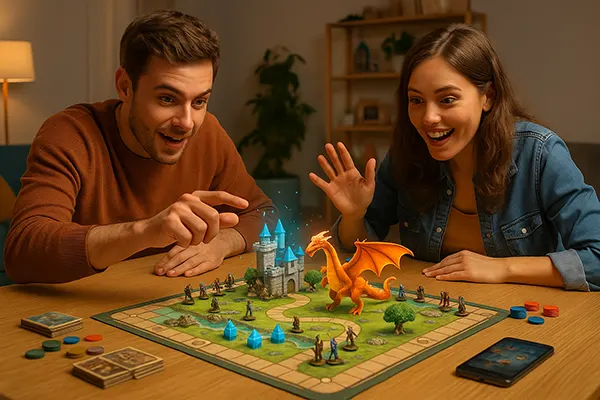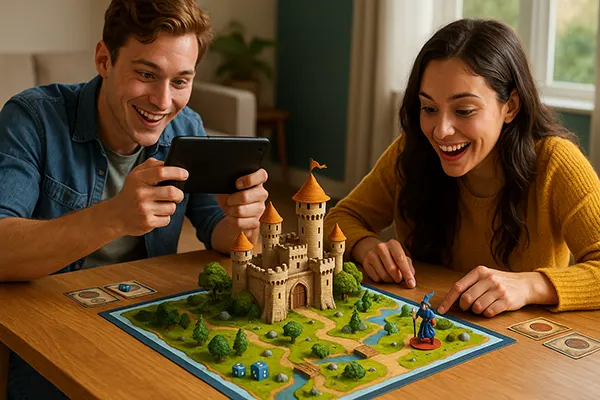
Board games are undergoing a quiet revolution. With the emergence of augmented reality (AR), developers are rethinking what it means to play around a physical board. By blending tangible pieces with digital overlays, AR is breathing new life into both classic mechanics and entirely new gaming genres. As of June 2025, AR-enhanced board games are more accessible and technologically mature than ever, offering engaging experiences for both casual players and enthusiasts.
The Evolution of Physical Gameplay through AR
AR is reshaping the way people interact with board games by introducing dynamic visuals, real-time effects, and responsive storytelling. Players no longer rely solely on imagination or printed rules – they can witness battles play out in 3D, environments shift, and characters react on the table in front of them. This technological overlay adds a new sensory dimension to tabletop sessions.
Through mobile devices or dedicated AR headsets, objects on the board can come to life. A castle may rise from the flat paper map, or a card might summon an animated creature. The physical pieces remain central, but now serve as anchors for interactive elements that evolve with gameplay.
Unlike virtual-only games, AR maintains the tactile and social advantages of board gaming. Friends still gather around the table, but now experience a shared augmented environment. This fusion helps preserve the charm of analogue gaming while offering digital depth.
Current Applications and Commercial Examples
Several games are already pushing the boundaries. Titles like “Tilt Five” and “MergeCube” bring holographic visuals to the table using AR glasses or smartphone apps. “Chronicles of Crime” allows players to scan locations and evidence cards to explore 3D crime scenes, blending deduction with immersive interaction. These examples demonstrate the practical versatility of AR in enhancing storytelling and decision-making.
In family gaming, AR adds a layer of excitement without complicating gameplay. For instance, “Pictionary Air” turns the air into a drawing canvas, where clues are visualised through screens in real time. Such mechanics cater to a broad audience and redefine accessibility.
Even educational board games have benefited. Geography-based titles integrate 3D maps and animations, providing younger players with an interactive way to learn. By linking play with visual information, AR supports memory retention and active engagement.
Design Innovations and Creative Opportunities
Game designers are exploring how to use AR not just to decorate, but to transform game mechanics. Some systems use environmental tracking to allow real-time board transformations, introducing fog, weather, or destructible terrain. These features add unpredictability and strategic depth that traditional formats can’t replicate.
AR also offers new tools for modular gameplay. Instead of fixed board layouts, designers can build experiences that adapt to player choices or real-world time. Boards can expand, shift, or respond to in-game events. This flexibility leads to higher replay value and richer immersion.
From a production perspective, AR can reduce manufacturing costs for visual complexity. Rather than printing dozens of detailed miniatures or cards, creators can rely on a limited set of physical items supplemented by digital content. This hybrid model makes ambitious games more financially viable for indie studios.
User-Created Content and Open Source Potential
Open AR development kits have empowered hobbyists to design their own scenarios, overlays, and animations. Platforms such as Unity’s AR Foundation or Apple’s ARKit make it possible to link object recognition to specific effects. This has spawned communities of tinkerers developing custom campaigns and fan expansions.
Some publishers are actively encouraging user participation. They offer downloadable AR modules, scenario editors, or animation packs that allow players to personalise their experience. This trend aligns well with the increasing appetite for creative freedom in hobby gaming.
In future, we may see board games as frameworks rather than fixed products – starting points for personal, augmented adventures shaped by the players themselves. This concept repositions the gamer as a co-creator rather than just a consumer.

Accessibility, Cost, and Future Prospects
One of the remaining challenges for AR in board games is accessibility. While many titles use smartphones to keep costs low, advanced headsets like HoloLens or Meta Quest are still financially out of reach for many. However, prices have been steadily dropping, and mobile-first AR remains the most viable path for mass adoption.
Battery life, calibration, and cross-platform compatibility are also key factors. Developers now focus on seamless experiences that require minimal setup. User feedback suggests that simplicity is crucial: no one wants to spend more time managing software than enjoying the game.
Looking ahead, the fusion of AI and AR could create board games that not only react visually, but also learn and adapt to player behaviour. These intelligent systems could offer tailored difficulty levels, evolving narratives, or even cooperative AI-controlled characters, bringing further innovation to the table.
Balancing Innovation with Tradition
Despite the impressive tech, most successful AR board games still prioritise simplicity and physical interaction. The best experiences enhance, rather than overshadow, the traditional appeal of face-to-face play. It’s about enhancement, not replacement.
Publishers are becoming more conscious of player preferences. Many include both standard and AR-enhanced modes to accommodate different playing styles or environments. This inclusivity supports wider adoption across varied demographics.
Ultimately, AR represents a complementary shift – one that invites experimentation without abandoning the roots of the medium. It’s a bridge between the old and the new, where tangible fun meets digital creativity.